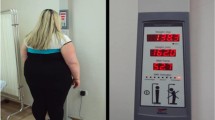Abstract
Background
Although total knee replacement (TKR) has been proven a very successful treatment modality for the end-stage knee osteoarthritis (OA) in obese patients, the rehabilitation period often is long and painful. Minimal invasive surgery (MIS) has gained much attention in TKR promising fast and less painful recovery. However, little is known about the effectiveness of the technique in the obese adult population.
Methods
One hundred consecutive patients with body mass index (BMI) > 30 kg/m2 and tricompartmental knee OA were randomly assigned to undergo either standard TKR (50 patients) or MIS-TKR (50 patients). The patients were assessed clinically and radiologically before the procedure and at subsequent postoperative follow-up visits, until 2 years after the operation.
Results
Knee society function and pain scores were significantly higher in MIS group for 3 months following surgery. Patients after MIS had also lower levels of pain during hospitalization. Tourniquet time was on average 7 min longer during MIS-TKR (p = 0.03) but operative time was almost equal in both groups (p = 0.11). No statistical significant difference was found between groups regarding the amount of blood loss (p = 0.49) or incidence of allogeneic blood transfusion (p = 0.27). Active straight leg raising was achieved 2.2 days earlier, on average, after MIS-TKR (p < 0.001). No severe complications or residual coronal and sagittal imbalance were identified. Component alignment was in normal limits and similar in both groups. In MIS group, higher BMI did not have a negative predictive effect on knee pain and function.
Conclusions
MIS is a reliable and safe option in obese patients undergoing TKR regardless the level of BMI. It is associated with improved early clinical outcome without sacrificing radiographic positioning of the implants.





Similar content being viewed by others
References
Gillespie GN, Porteous AJ. Obesity and knee arthroplasty. Knee. 2007;14:81–6.
Oliveria SA, Felson DT, Cirillo PA, et al. Body weight, body mass index, and incident symptomatic osteoarthritis of the hand, hip, and knee. Epidemiology. 1999;10:161–6.
Sahyoun NR, Hochberg MC, Helmick CG, et al. Body mass index, weight change, and incidence of self-reported physician-diagnosed arthritis among women. Am J Public Health. 1999;89:391–4.
Changulani M, Kalairajah Y, Peel T, et al. The relationship between obesity and the age at which hip and knee replacement is undertaken. J Bone Joint Surg Br. 2008;90:360–3.
Flugsrud GB, Nordsletten L, Espehaug B, et al. Risk factors for total hip replacement due to primary osteoarthritis: a cohort study in 50, 034 persons. Arthritis Rheum. 2002;46:675–82.
Vincent HK, Vincent KR, Lee LW, et al. Effect of obesity on inpatient rehabilitation outcomes following total knee arthroplasty. Clin Rehabil. 2007;21:182–90.
Amin AK, Patton JT, Cook RE, et al. Does obesity influence the clinical outcome at five years following total knee replacement for osteoarthritis? J Bone Joint Surg Br. 2006;88:335–40.
Krushell RJ, Fingeroth RJ. Primary total knee arthroplasty in morbidly obese patients: a 5- to 14-year follow-up study. J Arthroplasty. 2007;22:77–80.
Spicer DD, Pomeroy DL, Badenhausen WE, et al. Body mass index as a predictor of outcome in total knee replacement. Int Orthop. 2001;25:246–9.
Dalury DF, Dennis DA. Mini-incision total knee arthroplasty can increase risk of component malalignment. Clin Orthop Relat Res. 2005;440:77–81.
Insall JN, Dorr LD, Scott RD, et al. Rationale of the knee society clinical rating system. Clin Orthop Relat Res. 1989;248:13–4.
Lozano LM, Segur JM, Macule F, et al. Intramedullary versus extramedullary tibial cutting guide in severely obese patients undergoing total knee replacement: a randomized study of 70 patients with body mass index >35 kg/m2. Obes Surg. 2008;18:1599–604.
Laskin RS. Minimally invasive total knee arthroplasty: the results justify its use. Clin Orthop Relat Res. 2005;440:54–9.
Scuderi GR, Tenholder M, Capeci C. Surgical approaches in mini-incision total knee arthroplasty. Clin Orthop Relat Res. 2004;428:61–7.
Aglietti P, Baldini A, Giron F, et al. Minimally invasive total knee arthroplasty: is it for everybody? HSS J. 2006;2:22–6.
Lozano LM, Nunez M, Segur JM, et al. Relationship between knee anthropometry and surgical time in total knee arthroplasty in severely and morbidly obese patients: a new prognostic index of surgical difficulty. Obes Surg. 2008;18:1149–53.
Laskin RS, Beksac B, Phongjunakorn A, et al. Minimally invasive total knee replacement through a mini-midvastus incision: an outcome study. Clin Orthop Relat Res. 2004;428:74–81.
Haas SB, Manitta MA, Burdick P. Minimally invasive total knee arthroplasty: the mini midvastus approach. Clin Orthop Relat Res. 2006;452:112–6.
Seon JK, Song EK. Navigation-assisted less invasive total knee arthroplasty compared with conventional total knee arthroplasty: a randomized prospective trial. J Arthroplasty. 2006;21:777–82.
Tenholder M, Clarke HD, Scuderi GR. Minimal-incision total knee arthroplasty: the early clinical experience. Clin Orthop Relat Res. 2005;440:67–76.
Rama KR, Apsingi S, Poovali S, et al. Timing of tourniquet release in knee arthroplasty. Meta-analysis of randomized, controlled trials. J Bone Joint Surg Am. 2007;89:699–705.
Jones AP, Harrison M, Hui A. Comparison of autologous transfusion drains versus no drain in total knee arthroplasty. Acta Orthop Belg. 2007;73:377–85.
Kim YH, Kim JS, Kim DY. Clinical outcome and rate of complications after primary total knee replacement performed with quadriceps-sparing or standard arthrotomy. J Bone Joint Surg Br. 2007;89:467–70.
Kolisek FR, Bonutti PM, Hozack WJ, et al. Clinical experience using a minimally invasive surgical approach for total knee arthroplasty: early results of a prospective randomized study compared to a standard approach. J Arthroplasty. 2007;22:8–13.
Haas SB, Cook S, Beksac B. Minimally invasive total knee replacement through a mini midvastus approach: a comparative study. Clin Orthop Relat Res. 2004;428:68–73.
Tria AJ Jr, Coon TM. Minimal incision total knee arthroplasty: early experience. Clin Orthop Relat Res. 2003;416:185–90.
Aglietti P, Baldini A, Sensi L. Quadriceps-sparing versus mini-subvastus approach in total knee arthroplasty. Clin Orthop Relat Res. 2006;452:106–11.
Author information
Authors and Affiliations
Corresponding author
Rights and permissions
About this article
Cite this article
Chalidis, B.E., Petsatodis, G., Christodoulou, A.G. et al. Is Obesity a Contraindication for Minimal Invasive Total Knee Replacement? A Prospective Randomized Control Trial. OBES SURG 20, 1633–1641 (2010). https://doi.org/10.1007/s11695-009-9968-6
Received:
Accepted:
Published:
Issue Date:
DOI: https://doi.org/10.1007/s11695-009-9968-6




